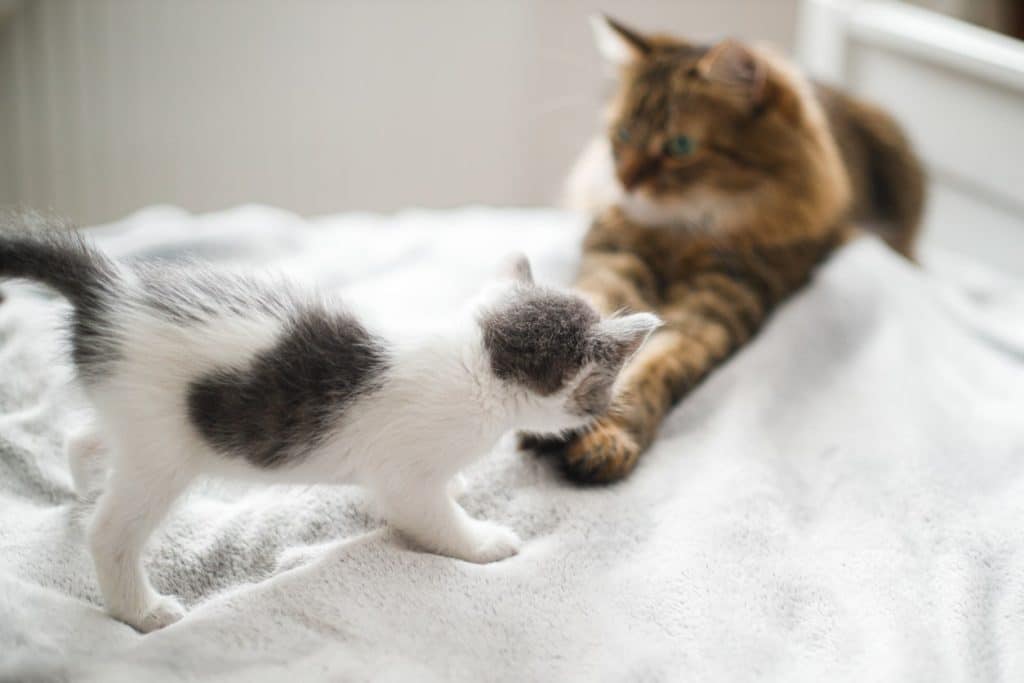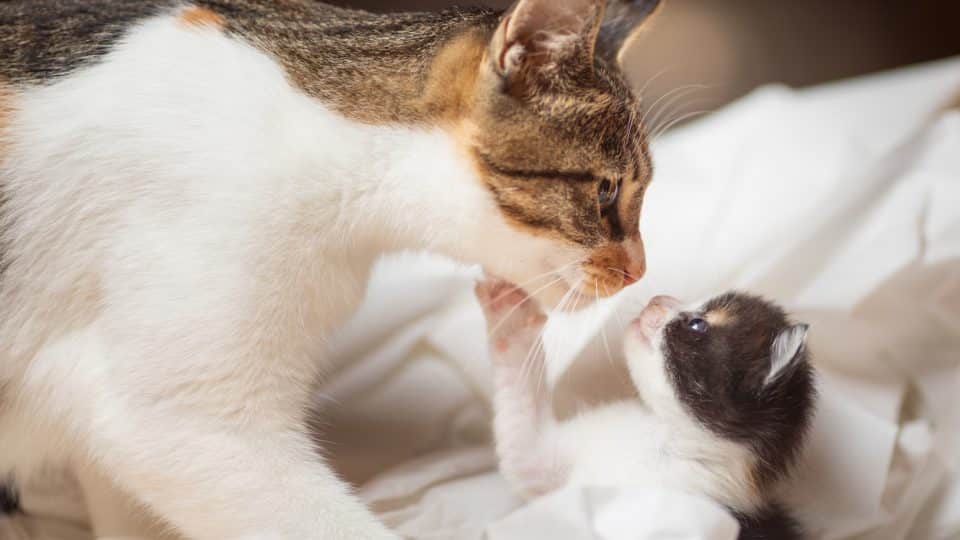- This article has been reviewed by a pet health professional. It is not a substitute for professional veterinary advice.
Thinking of getting your cat a little buddy to play with? Then you’ll need to know how to introduce a kitten to a cat so that they can get off on the right paws.
In the best-case scenario, introducing two cats could take as little as a week. For more stubborn or pessimistic cats, you may need to wait up to six months before you can leave the cats alone together. Hopefully, with our guide, you’ll be able to keep the time down to a minimum!
1. Set Up a Kitten-Only Space
Before introducing a new kitten to cats, you’ll want to set up a space for your new kitten in your home that’s just for them. They’ll need their own litter box, bed, some food and water, plus some toys and scratchers will never go amiss.
Try to think of an area in your home where your first cat doesn’t tend to visit very often, perhaps a spare room, second bedroom, or dining room. That way, your kitten can enjoy some peace while your cat can continue to reign over her territory. (For the time being!)
It’s important that during the introduction process each cat has their own place to go and feel comfortable. And you’ll need to take time introducing your kitten to her new surroundings, too.
2. Take Care of Vet Visits Beforehand
If your kitten hasn’t seen the vet or had their vaccines yet, it’s important to restrict contact between kittens. While kittens do get some natural immunity from their mothers and their milk, this immunity declines over time. Your vet will recommend setting up a regular vaccine schedule from around 2-3 months old.
The vet will also treat your kitten for worms and against fleas. This helps avoid an infestation in your new two-cat household.
Pro tip: Another trick to consider using before introducing kittens to cats is to groom them and trim their nails beforehand. Since cats groom themselves as a stress response, brushing them will put them in a nice calm mood before meeting their new buddy. If both cats feel at ease on their first meeting, they will be in a better place to forge a bond.
3. Introduce Scented Items First
Prior to meeting face to face, present your older cat with something the kitten has played with or slept on so he can get used to the kitten’s smell.
New smells can be overwhelming and unsettling since cats have more smell receptors than we do. In fact, research shows that cats have a sense of smell that is about 14 times stronger than humans.
After about a week, however, both cats should be used to the new smells in their environments, signalling the next step…

iStock/Bogdan Kurylo
4. Let Them Meet Behind a Playpen
A great way to maintain control over a kitten and cat’s initial encounter is to use a playpen to allow each cat to sniff each other first. This will let them suss each other out before interacting fully.
Use this technique for several days and observe your cats. As the week goes on, you may find that the cats stop hissing at each other (progress!), lose interest in sniffing each other (a good sign), or start looking forward to their encounters (a great sign!).
5. Let Your Cats Set the Pace
Don’t be dismayed if your cat hisses, arches their back, or gets a fluffy, angry tail when they first meet. Remember that cats are solitary, independent (and sometimes territorial) creatures. Even if introductions don’t go well at first, there is still plenty of time for your cats to learn how they can live with and love each other.
It may take several days, or even a week or two, before your cats are ready for full interaction. Just be sure to let your cats set the pace.
Pro tip: As well as grooming, calming sprays can help your cat’s anxiety and put them in a better mood for meetings.
6. Use Food to Create a Positive Relationship
Treats are a great method of positive reinforcement for cats and kittens alike. So when your cats meet each other from behind the gate, reward good behaviour with a treat. This way they will begin to associate friendly interactions with a reward.
Meal times are also a good time for cat meetings, both with or without a baby gate. This way, each cat will be occupied with their dinner, happily filling their bellies whilst getting used to each other’s presence.
Of course, make sure each cat has enough space to enjoy their meal without the other getting in the way—having them both eat from the same food bowl is a recipe for disaster! But the cats should still be able to see each other while eating, so they start associating seeing their new pal with eating a delicious meal.
7. Have Patience
Slow and steady should remain your mantra until your cat and kitten can occupy the same space peacefully. Introducing a new kitten to a cat can require a lot of trial and error, so it’s important to be patient until your cats feel comfortable.
Whether it takes a couple of weeks or a few months, usually your cats will eventually reach a compromise and hopefully start to enjoy each other’s company. Don’t be too dismayed if it’s taking longer than you’d hoped—remember that there’s nothing wrong with your cats if they don’t bond right away, and you’ve not failed as a pet parent either. Simply trust the process and see it through.
Keep an Eye Out for Warning Signs and Unusual Behaviour
While play fighting is normal (and pretty cute!), aggression from either side of your kitten-cat combo is not to be tolerated.
Pro tip: Notice your cat stalking, chasing, or pouncing? Distract your cat from these negative behaviours with a toy. And remember to reward good behaviour with treats, too!
Signs of aggression can include:
- Dilated pupils
- Ears flattened backwards on the head
- Tail pointing up and straight
- Hairs standing on end
- Arched back
On the other hand, signs of fear can be:
- Dilated pupils
- Ears flattened and held outward
- Flattened whiskers
- Wrapping the tail around or tucked under the body
- Holding head up while lying flat
If you’re noticing any of these behaviours, as well as more extreme stress—such as inappropriate urination, destructive scratching, or overgrooming—it’s time to take a step back and reassess. You might need to start the process over again.
When to Call In a Professional
If you are not having success introducing your kitten to your cat, you can always work with your vet to develop the best strategies. Vets are a fountain of information that you can take advantage of and will always be happy to help.
Looking to introduce two older cats? The process is exactly the same! However, some considerations might be different, such as energy levels.
And what about introducing a cat to a dog house? Well, that’s a whole other kettle of fish! But you can use some of the same techniques here, too. For more in-depth advice on introducing a cat or kitten to your dog, take a look at our articles:



